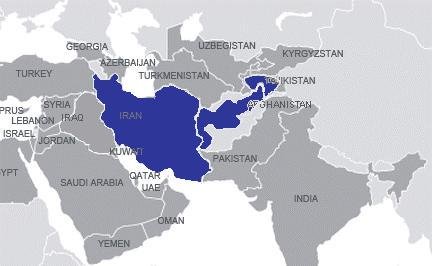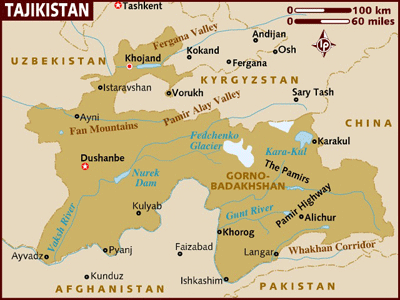Written Farsi/Persian Language
e(fārsī) فارسى

Looking at the map, the use of Farsi written language extends from Iran, through the middle of Afghanistan, into Tajikistan.
Farsi is written from right to left, usually in a cursive style with some letters joined:
Farsi spoken dialects.
Farsi, also known as Persian Language is spoken today primarily in Iran and Afghanistan (Dari dialect). Total numbers of speakers is high: over 30 million Farsi speakers (about 50% of Iran's population); over 7 million Dari Persian speakers in Afghanistan (25% of the population); and about 2 million Dari Persian speakers in Pakistan.
Farsi written language.
Farsi in Iran is written in a variety of the Arabic script called Perso-Arabic:English words of Farsi origin include "shawl", "pyjama", "taffeta", "khaki", "kiosk", "divan", "lilac", "jasmine", "julep", "jackal", "caravan", "bazaar", "checkmate" and "dervish".
Farsi language
Farsi is also referred to as Persian and is the main official language in Iran (based on the ancient dialect spoken in the south-western part of the country, in the province of Fars, as it is still known today).
 Farsi
uses a modified Arabic alphabet. Like Arabic, it is written from right
to left.
Farsi
uses a modified Arabic alphabet. Like Arabic, it is written from right
to left.
Farsi is used in other countries and regions, besides Iran:
- Tajikistan (Tajik, Тоҷики / تاجيكى)
- Afghanistan (Dari, درى)
 The
map to the left shows Iran, the main Farsi speaking country.
The
map to the left shows Iran, the main Farsi speaking country.
Extensive contact with Arabic in its history led to a large influx of Arab vocabulary. This Farsi (Modern Persian) dialect still contains a large number of Arab terms, most borrowings have been nativised.
When Persia changed its name to Iran
In 1935 the Iranian government requested those countries which it had diplomatic relations with, to call Persia "Iran," which is the name of the country in Persian.
The suggestion for the change came with the advent of Reza Shah, Persia had turned a new leaf in its history and wanted to herald a new era in Iranian history free from British and Russian influences which had crippled the country.
Tajikistan

Tajik (Тоҷики / تاجيكى) is a dialect of Farsi. It is spoken with some variation from Iranian Farsi.
In the written form it differs in that it uses the cyrilic alphabet, not the modified Arabic alphabet like Iran. This stems from its union with the Soviet Union and Russian influences.
Afghanistan

Written modern Farsi is virtually identical in Iran and Afghanistan, with very minor lexical differences.
Dari (درى) which is spoken in most of Afghanistan (one of two official languages) is a spoken dialect of Farsi.
Dari is spoken in the North, West and central areas of Afghanistan, and is the common language spoken in cities such as Kabul, Herat, Mazar-i-Sharif, Fayzabad, Panjshir, and Bamiyan.
In the South, Pashto is the main language.
In its written form, it uses the Arabic alphabet, so is written from right to left.
Improvements to this site?
Farsi Translation sample:
تمام افراد بشر آزاد زاده میشوند و از لحاظ حيثيت و كرامت و حقوق با هم برابراند. همگی دارای عقل و وجدان هستند و بايد با يكديگر با روحيه ای برادرانه رفتار كنند.
Tajiki Translation sample:
Ҳамаи афроди башар озод ба дунё меоянд ва ҳайсияту ҳуқуқашон бо ҳам баробар аст, ҳамаашон андешаву виҷдон доранд ва бояд дар баробари якдигар бо рӯҳи бародарӣ рафтор кунанд.
All human beings are born free and equal in dignity and rights. They are endowed with reason and conscience and should act towards one another in a spirit of brotherhood. (Article 1 of the Universal Declaration of Human Rights)
Farsi Speaking countries
Iran, Tajikistan, Afghanistan.
Difficulty in learning Farsi as a native English speaker
The Defense Language Institute categorizes Farsi as difficult (level 3, of 4 levels)
Farsi letter writing samples
- Letter (formal)
- Letter (informal)
Iranian Business Etiquette
- Meeting
Introductions are generally restricted to members of the same sex since men and women socialize separately.
Greetings tend to be affectionate. Men kiss other men and women kiss other women at social events. If they meet on the street, a handshake is the more common greeting.
The most common greeting is "salaam alaykum" or more simply "salaam" (peace).
In Business, who you know is often more important than what you know, so it is important to network and cultivate a number of contacts as Iranians prefer to do business with those they know and respect.
Expect to be offered tea whenever you meet someone, as this demonstrates hospitality.
It is a good idea to avoid scheduling meetings during Ramazan (Ramadan) as the need to fast would preclude your business colleagues from offering you hospitality.
The first meeting with an Iranian company is generally not business-focused. Expect your colleagues to spend time getting to know you as a person over tea and snacks.
Do not remove your suit jacket without permission.
- Eating
If you are invited to an Iranian's house:
Check to see if the host is wearing shoes. If not, remove yours at the door.
Dress conservatively.
Show respect for the elders by greeting them first.
Check to see if your spouse is included in the invitation. Conservative Iranians do not entertain mixed-sex groups.
Accept any offer of food or drink. Remember to do 'taarof'.
Table manners: Iranians are rather formal. Although some meals in the home are served on the floor and without eating utensils, it does not indicate a lack of decorum. In more modern homes, meals are served on a dining table with place settings.
Eat only with the right hand.
There is often more food than you can eat. Part of Iranian hospitality is to shower guests with abundance.
Expect to be offered second and even third helpings. Initial refusals will be assumed to be polite gestures (taarof again!) and are not taken seriously.
Restaurants generally have two sections - "family" where women and families dine and "men only". Tips of between 10 and 15% are appreciated in hotel restaurants.
- Negotiation
Personal relationships form the basis of business dealings.
Iranians are deliberate negotiators who can drive a hard bargain.
Iranians often use time as a negotiating tactic, especially if they know that you have a deadline. Be cautious about letting your business colleagues know that you are under time pressure.
Companies are hierarchical. Decisions are made at the top of the company, either by one person or a small council.